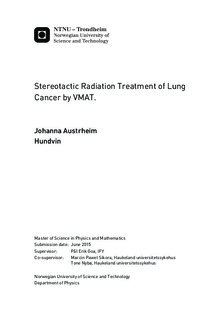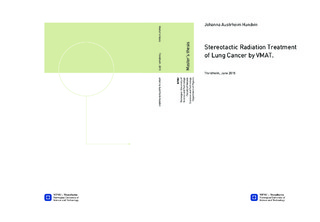| dc.description.abstract | Radiotherapy of early stage non-small cell lung cancer (NSCLC) is a challenging treatment due to the varying tissue densities in the irradiated volume and the moving target. At Haukeland University Hospital (HUH) the treatment is performed by stereotactic body radiotherapy (SBRT) using the conventional technique with flattening filter (FF) included. Advances in treatment planning and delivery facilitates the use of volumetric arc modulated therapy (VMAT) with the flattening filter removed, with the potential of a more conformal dose distribution, elevated target dose for increased tumour control and shorter delivery time. However, the requirement of clinical dose accuracy is crucial for the treatment outcome, and has to be taken into account with the utmost care. The aim of this study is to establish a method for robust SBRT treatment of NSCLC using the FFF VMAT technique.
Five patients with NSCLC earlier treated with SBRT at HUH have been used as patient material of the investigation. The patients had prescribed doses of 54 or 55 Gy, tumours with a craniocaudal motion larger than 5 mm and an ITV size in the range of 1.7 cm3 to 58.6 cm3. The Analytical Anisotropic Algorithm (AAA) have been evaluated in comparison to a newly developed in-house Monte Carlo (MC) algorithm using phantom simulations and measurements on the Delta4 phantom (ScandiDos AB, Uppsala, Sweden). Three different CT bases have been used in the treatment planning process (MIP, AI and density overwrite). For each patient, FFF VMAT treatments plans with energy of 6 MV and 10MV were generated in EclipseTM by AAA for each of the three CT bases, resulting in six new plans per patient. All plans were then recalculated by the MC algorithm. For verification, the MC dose of each phase of the 4D CT scan was accumulated using a deformable registration program Matcher3D developed by Söhn et. al..
The 6 MV FFF and 10 MV FFF beams showed good agreement in water density, with symmetric errors up to 2% relative to the maximum dose. The AAA density handling in homogeneous matter was suitable, while heterogeneous media lead to prominent deviations due to the lateral electronic disequilibrium (LED) effect. The deviation between the AAA and MC calculated dose distributions tended to increase with increasing energy. The density overwrite basis lead to good correspondence between the AAA and MC calculated dose distributions, but resulted in remarkably deviations between the planned and accumulated doses. For the MIP and AI CT bases, the deviation between planned and accumulated dose was smaller, in addition to an in general smaller variation. The largest tumours investigated showed to have results best predicted by the planning algorithm. For the smallest tumour evaluated with an ITV volume of 1.7 cm3 none of the bases gave adequate results, and planning optimisation by MC instead of AAA is recommended.
The method of robust SBRT NSCLC FFF VMAT treatment planning and verification still needs further developments of the MC algorithm, in addition to automated procedure steps for time reduction. The FFF VMAT treatment of NSCLC lead to dose distributions of higher conformity index, higher target dose and lower dose to adjacent tissue than then conventional treatments, validated by MC calculations and dose accumulation. | |

